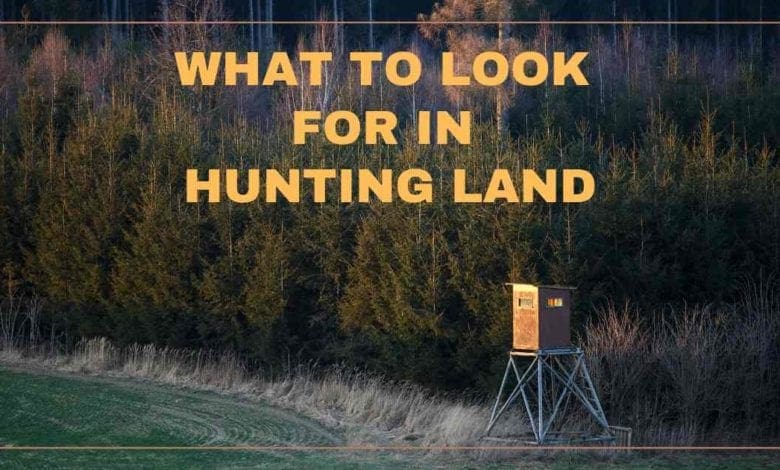What To Look For In Hunting Land

Whether looking to lease or purchase, the ability to hunt begins with having a place to base your efforts. While it is true that many states offer public land hunting access, nothing beats having your own place to hunt. However, it is important to understand what to look for when seeking land access for the purpose of hunting.
Although it would appear that the high points of what to look for when seeking a place to hunt would differ based upon what game species you are hunting, this is not necessarily the case. The truth is, all species of game require at least some form of the same three items for survival.
Ample Availability of Food
The first consideration that must be made when assessing the potential of a given property for the purpose of hunting, is the availability of food on, or close to, the property in question. All game animals require food for regular consumption, and their need to feed typically reigns supreme over all else.
If a property contains a plentiful food source, deer, turkey, and other game are almost certain to be near if their other daily needs are met. Food sources can come in multiple forms, but the most prominent of all are those that are agricultural in nature.
The presence of regular annual crops on, or next door to, a prospective hunting property, is of significant value in the ability to attract and hold game. Large stands of corn or soybeans provide excellent summer/fall forage, and are typically followed up with a cover crop that provides food into the following spring.
Another high impact food source to keep an eye out for is any significant stand of fruit or mast bearing trees. This can include oak flats containing red or white oak trees, or fruit tree orchards that are abundant in apple, peach, pear, or persimmon trees.
If little in the way of existing food sources are available on a particular property, you must assess whether or not it will be possible to provide such food yourself. This includes asking yourself whether or not enough accessible open ground exists to plant food plots or similar sources of forage.
Sustainable Water Sources
The next consideration, which must be made when assessing a particular piece of property’s worth for hunting, is the presence of sustainable water sources. Every species of game requires water for daily consumption. Without any available source of water, these same game animals will travel heavily in search of what they need.
Water sources on a property can come in many forms, although not all are sustainable during every point of the year. Small watering holes and shallow running creeks are wonderful sources of water when regular rainfall occurs. However, these shallow basins will typically be absent of water during drier months.
The most highly valued of all water sources include rivers, year-round streams/creeks, and significant sized ponds. These locations tend to be reliable sources of water, which game learn to incorporate within their day to day travel patterns.
A water source offers increased value to game of a particular area if it is in close proximity to sources of food and cover. Many game species, including deer, are far more likely to venture to a given water source during daylight hours when they are not required to venture far from the safety of their bedding areas.
If no year-round source of water is present on a property, the possibility exists, in many cases, to construct one yourself. Digging and lining small watering holes by hand is quite popular, yet somewhat unreliable in its ability to produce suitable year-round results.
However, fair results can be achieved when using heavy equipment to excavate a dedicated impoundment such as a pond. In many cases, these ponds are dug to a depth that prevents them from going dry during periods of drought.
Sufficient Security Cover
Game animals of every type require some form of cover for an escape from predators and other forms of danger. What exactly this cover consists of often differs from one species to the next. Deer favor dense brush that still affords a certain level of visibility, while turkeys require sufficient trees for roosting in the evening time.
A property should offer a diverse array of cover, as this presents favorable habitat for several game species, all on the same parcel of land. Undisturbed hardwood ridges, lowland swamps with intermittent brush-covered islands, and densely vegetated creek or riverbanks all offer cover of a diverse nature.
Another wonderful source of bedding cover is any farm or plot of land that is enrolled in some form of natural growth conservation program. A number of these government-funded programs exist, and nearly all substantially enhance cover for numerous types of wildlife.
In certain cases, bedding cover can be created, though it is helpful to at least have some established form of cover already at your disposal. Fields can be allowed to grow in absence of clipping, hinge cutting of wooded lots can be conducted, and additional forms of strategically placed dense growth species can be planted.
The Perfect Piece of Property
While excellent hunting can be found in a variety of settings, the presence of these three key factors on any given property will virtually ensure that above-average hunting potential exists. As a general rule, game will roam no further than necessary to locate what is needed for survival.
By locating a property that offers an ample source of food, abundant water, and a sufficient amount of security cover, game animals are given everything they need to survive in a single location, promoting quality hunting at every turn. With this three-part recipe in place, hunting success is sure to soon follow.
Darren Webster

Darren Webster is an avid hunter of over thirty years, and strategically manages several properties that he owns, as well as those that he leases. He also is the chief-editor of UberBows.com, a site purely dedicated to bowhunting and archery.
